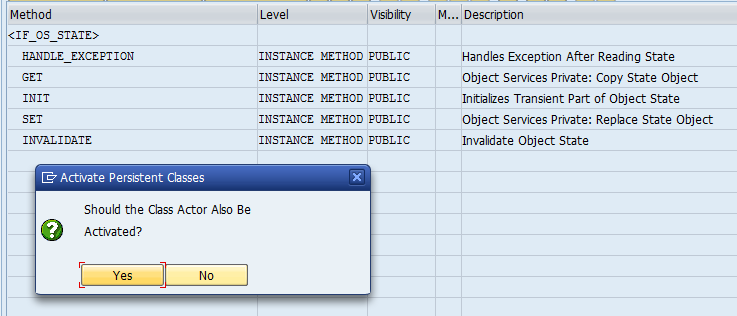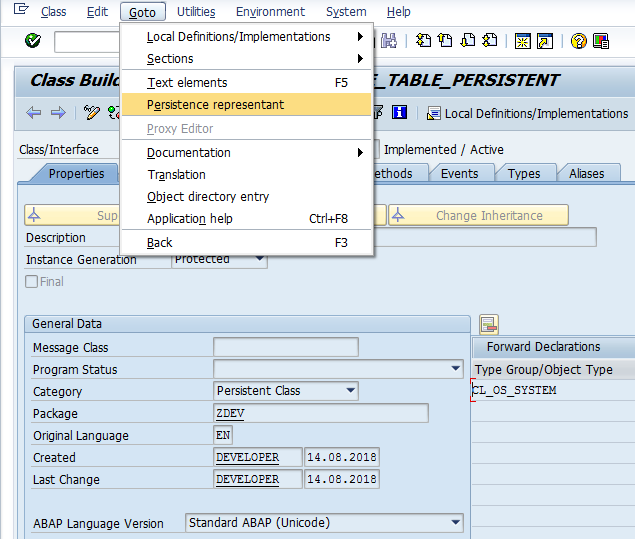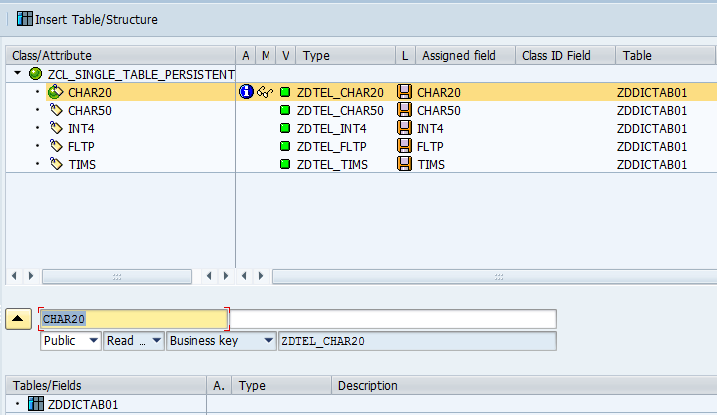
- SAP Community
- Groups
- Interest Groups
- Application Development
- Blog Posts
- ABAP Object Services Technique
Application Development Blog Posts
Learn and share on deeper, cross technology development topics such as integration and connectivity, automation, cloud extensibility, developing at scale, and security.
Turn on suggestions
Auto-suggest helps you quickly narrow down your search results by suggesting possible matches as you type.
Showing results for
roberto_forti
Contributor
Options
- Subscribe to RSS Feed
- Mark as New
- Mark as Read
- Bookmark
- Subscribe
- Printer Friendly Page
- Report Inappropriate Content
10-21-2022
7:10 PM
ABAP Object Services
In this blog you are going to read some information about ABAP Object Services and how to create persistent class object with single-table using mapping assistant tool, create object instance with class agent, consumer perspective and record converted into database table.
#1. Creating Persistent Object with single-table
SAP Community has introduced excellent Professionals to SAP world as well as providing opportunity for all to writing blog posts which has helped us to improve SAP knowledge.
One of many important SAP techniques which I have been reading about is ABAP Object Services applying object-oriented concept.
This first blog post will show a simple way of creating persistence class working with single-table.
1. ABAP Object Services – Creating Persistent Object with single-table
- Objective: handling the synchronization of data stored in objects with database table creating a method to synchronize object data with a relational database table considering object relational mapping (ORM) tool.
- Object Service by SAP documentation.
- Following simple steps to create persistence class.
1.1. Creating Persistent Class (SE80)
- Start transaction SE80 to create a Persistence class without “Final” class checked.
- Persistent Class and Final Class by SAP documentation.

- Confirm “Yes” to activate Class Agent – “At runtime, Class Agent run between persistent objects and the ABAP Object Services”.

- Agent ABAP Persistent Class implemented.

1.2. Working with single-table using Mapping Assistant tool
- Going to Persistence Representing to add single-table
- Database Table by SAP documentation

- Insert table/structure for corresponding class.

- By Business Key – ABAP Dictionary tables which use exiting primary key.
- Primary Key by SAP documentation

- Mapping Assistant tool – Click on Generator Settings button and uncheck the minimum Interface for methods CREATE_PERSISTENT and CREATE_TRANSIENT.

1.3. Persistent objects – Consumer Perspective
- Persistent objects are managed by object services.
- Persistent Object by SAP documentation

1.4. Creating Persistent Object Instance with class agent
- ABAP code example: Simple report with corresponding statement Persistent Class and Agent Class working with synchronization of data stored in objects with a relational database table.
*&---------------------------------------------------------------------*
*& Report ZABAP_PERSISTENT_OBJECT
*&---------------------------------------------------------------------*
REPORT zabap_persistent_object.
*&---------------------------------------------------------------------*
*& DATA OBJECT
*&---------------------------------------------------------------------*
DATA: lo_cl_persist TYPE REF TO zcl_single_table_persistent,
lx_os_ex TYPE REF TO cx_os_object_existing,
lv_text TYPE string.
*&---------------------------------------------------------------------*
*& START-OF-SELECTIONf)
*&---------------------------------------------------------------------*
START-OF-SELECTION.
TRY.
lo_cl_persist = zca_single_table_persistent=>agent->create_persistent(
i_char20 = 'TEST01'
i_int4 = 1
i_char50 = 'TEST-01'
i_fltp = '100.50'
i_tims = sy-uzeit ).
COMMIT WORK.
CATCH cx_os_object_existing INTO lx_os_ex.
lv_text = lx_os_ex->get_text( ).
ENDTRY.* COMMIT WORK: Persistence Service convert in-memory record into the Database table.
- Commit Work by SAP documentation
1.5. Record converted into Database table
- Transactions SE11, SE16 and SE16N to check it.

Certainly, learning ABAP Object Services technique will improve technical knowledge as well as makes the ABAP code flexible to implement persistence without writing SQL.
Is recommended reading SAP documentation and practicing it to understanding each detail.
Following excellent SAP documentation to support understanding ABAP Object Services technique.
SAP suggest that following SAP community is a perfect way to learn, improve and share technical skills and others posts regarding SAP best practices as the following useful blog links:
Useful Blogs
- https://community.sap.com/topics/abap
- https://blogs.sap.com/2021/10/19/new-kinds-of-abap-expressions/
- https://answers.sap.com/tags/833755570260738661924709785639136
Finally, It always is a pleasure sharing a small peace of knowledge after learning from SAP community experts.
Thank you for reading this post and be nice with SAP community colleagues as well as sharing your feedback.
- SAP Managed Tags:
- ABAP Development
6 Comments
You must be a registered user to add a comment. If you've already registered, sign in. Otherwise, register and sign in.
Labels in this area
-
A Dynamic Memory Allocation Tool
1 -
ABAP
8 -
abap cds
1 -
ABAP CDS Views
14 -
ABAP class
1 -
ABAP Cloud
1 -
ABAP Development
4 -
ABAP in Eclipse
1 -
ABAP Keyword Documentation
2 -
ABAP OOABAP
2 -
ABAP Programming
1 -
abap technical
1 -
ABAP test cockpit
7 -
ABAP test cokpit
1 -
ADT
1 -
Advanced Event Mesh
1 -
AEM
1 -
AI
1 -
API and Integration
1 -
APIs
8 -
APIs ABAP
1 -
App Dev and Integration
1 -
Application Development
2 -
application job
1 -
archivelinks
1 -
Automation
4 -
BTP
1 -
CAP
1 -
CAPM
1 -
Career Development
3 -
CL_GUI_FRONTEND_SERVICES
1 -
CL_SALV_TABLE
1 -
Cloud Extensibility
8 -
Cloud Native
7 -
Cloud Platform Integration
1 -
CloudEvents
2 -
CMIS
1 -
Connection
1 -
container
1 -
Debugging
2 -
Developer extensibility
1 -
Developing at Scale
3 -
DMS
1 -
dynamic logpoints
1 -
Eclipse ADT ABAP Development Tools
1 -
EDA
1 -
Event Mesh
1 -
Expert
1 -
Field Symbols in ABAP
1 -
Fiori
1 -
Fiori App Extension
1 -
Forms & Templates
1 -
General
1 -
Getting Started
1 -
IBM watsonx
1 -
Integration & Connectivity
9 -
Introduction
1 -
JavaScripts used by Adobe Forms
1 -
joule
1 -
NodeJS
1 -
ODATA
3 -
OOABAP
3 -
Outbound queue
1 -
Product Updates
1 -
Programming Models
14 -
Restful webservices Using POST MAN
1 -
RFC
1 -
RFFOEDI1
1 -
SAP BAS
1 -
SAP BTP
1 -
SAP Build
1 -
SAP Build apps
1 -
SAP Build CodeJam
1 -
SAP CodeTalk
1 -
SAP Odata
1 -
SAP UI5
1 -
SAP UI5 Custom Library
1 -
SAPEnhancements
1 -
SapMachine
1 -
security
3 -
text editor
1 -
Tools
17 -
User Experience
5
Top kudoed authors
| User | Count |
|---|---|
| 5 | |
| 5 | |
| 3 | |
| 3 | |
| 3 | |
| 2 | |
| 2 | |
| 2 | |
| 1 | |
| 1 |